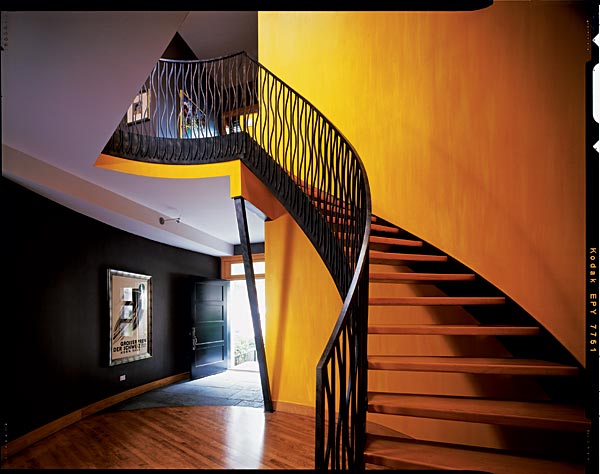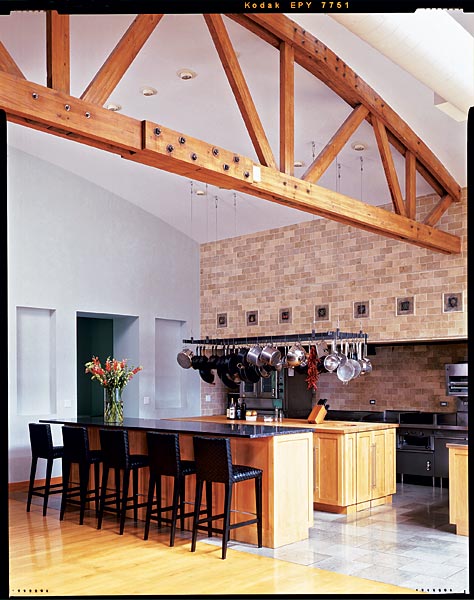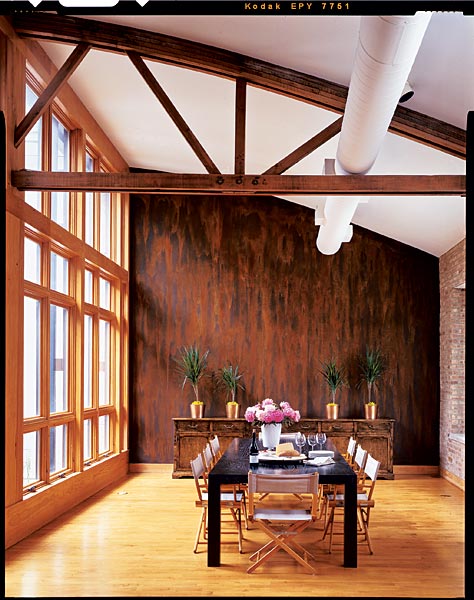
For the dramatic stairway in the foyer, architect Foster Dale designed a steel railing with a hint of an Art Deco sensibility. Bluestone tile meets maple flooring in a curve that reflects the circular stair opening above. Light from windows at the top of the stairs floods the space below. Photo Gallery::: |
The two-story limestone and brick building is large but does not overwhelm its bungalow neighbors. Parts of its façade have been rebuilt with a checkerboard pattern; industrial-style light fixtures are a nod to the building’s past as an early-20th-century soda pop factory. A cobalt blue doorbell is a small clue that something different is bubbling on this quiet side street.
The owners, who previously lived in a converted River West warehouse, are part of a wave of gentrification that is slowly reaching this South Side neighborhood. They began looking to build a larger home when their first daughter was born nine years ago. Dismayed at the sky-high prices in Bucktown and Wicker Park, they scouted neighborhoods all over the city before landing this approximately 6,000-square-foot space, which formerly housed a Girls Club of America and, most recently, a two-flat residence.

Warm maple cabinetry provides comfortable contrast to gray limestone finishes. Photo Gallery::: |
The husband, who had renovated the River West warehouse before the couple married, was quick to grasp the old factory’s potential. “He could see the prospects much more than I could,” says the wife. “I could see that it had the barrel-truss roof in back, but the ceilings were low and the rooms were small. There was no atrium area. But he could envision all the possibilities it might have.”
They closed on the property in December 1999 and by the end of that month, the building was gutted. After that, though, they were determined to take their time to create a unique home that they would truly love. The husband, who runs several business ventures, served as the general contractor for the project.
“He very clearly knew what he wanted in the kitchen and in other parts of the house,” says the wife. “We thought he was better off finding the materials himself than directing other people.” The couple, whose daughters are now four and nine, moved in four and a half years later.
“I can honestly say there is nothing in the house that we ‘settled’ for,” says the wife. “We chose what we liked, and if we had to, we would hold back the progress on other parts of the house to make it happen.”
One of the couple’s first challenges was to bring in as much light as possible. “This type of industrial building is inherently dark inside,” says architect Foster Dale, who worked with the owners. “There is a lot of volume, and we wanted to bring in a lot of natural light.”
Now as you walk into the house, windows at the top of a circular center stairwell bathe the foyer in light. Three walls of glass windows in the back of the house bring light in and offer an entrance to the atrium. Glass block windows in the dining room obscure the view of a parking lot and still let in light.
“I really wanted a warm, inviting space,” says the wife. “We were living in a warehouse with cement floors. It was very industrial. There’s nothing warm and fuzzy about that.”
The rooms in the front of the house—an office, playroom, and guest bath on the first floor and one of the children’s bedroom suites upstairs—have curved walls that follow the architecture of the rounded stairwell. Gray foyer walls have a soft, brushed appearance that serves as a backdrop for pieces from the couple’s eclectic art collection, including a trio of sunflowers painted by a local artist, framed labels from food crates, and posters from trips to Paris. Custom ironwork garnishes the staircase and landing, whose walls are painted in shades of yellow.
“We really struggled with the color in the stairwell, but with the amazing sunburst of light from the windows, it turned out just perfect,” the wife says.
Another challenge was learning to think big—essential when furnishing such a large, open space. The restaurant-quality kitchen features maple cabinetry, an enormous walk-in pantry, a food-prep island topped with butcher block, and a separate island with black barstools, for casual dining.
In the living room, two oversized sofas, custom made by Cambium and upholstered in easy-to-clean charcoal gray ultrasuede, satisfy the space. Plum brocade pillows and a Crate & Barrel coffee table provide accents.
“People seem to like to be here, which I like,” says the wife. “The oversized kitchen and open living room invite lingering. We entertain a fair amount and we cook together a lot, and there is a lot of room to work together easily.”

The industrial past of the former factory lives on, subtly, in the crisp look of the façade and in elements like exposed ductwork and barrel-trussing in the dining area. Walls of windows provide natural light in the rear of the building. Photo Gallery::: |
In the dining area, a ten-foot-long ash table is washed in a black finish and flanked by canvas-backed director’s chairs. A wall is painted in shades of gray and brown to give it a rusted-metal appearance. While most of the furniture is decidedly modern, a long buffet is anything but. “It was part of our intention that we wouldn’t automatically rule out more traditional pieces,” the wife says. “We tried to create an eclectic mix of things we really care for.”
Another traditional piece is a bench from the husband’s parents’ house that will eventually be reupholstered and shortened to fit under a window on the second-floor landing. The master bathroom, however, has a modern wide concrete sink and a stainless steel tub. The look is softened with an antique metal-framed mirror that spans the width of the sink.
“My husband had saved a picture of a sink from a design book,” she says. “He found a vendor to create it and now the vendor displays a variation of it in his showroom.”
Some parts of the house still are not completed. A rooftop deck is working its way up the priority list. And an atrium—complete with a waterfall—where the wife envisions sipping coffee and reading the paper, is not yet finished.
“I’ve learned to have a lot of patience with this house,” she says. “We don’t have any intention of leaving. This is a very personal home, filled with things we love and things we have a shared interest in. I was just thinking that this would be the perfect place for my daughters to get married.
“I see so much of my husband and his passions in this house,” she continues. “I see his attention to detail in the solid bedroom doors, the way the floor is laid, the iron railing, the whimsical drawer pulls in the kids’ rooms—it all speaks to his vision.”


